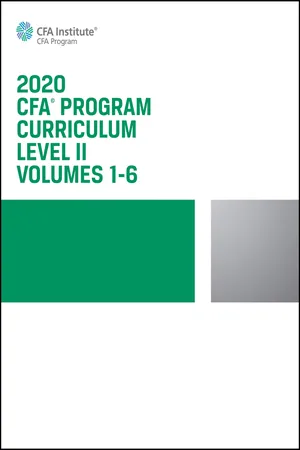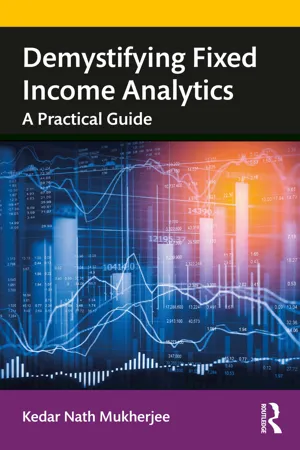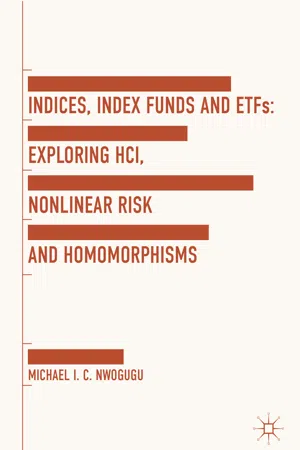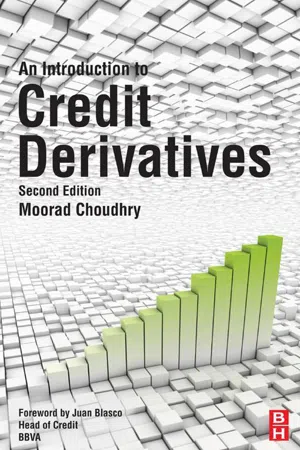Credit Default Swaps
Credit Default Swaps (CDS) are financial derivatives that allow investors to hedge against the risk of default on a loan or bond. In a CDS, the buyer makes periodic payments to the seller in exchange for protection against potential credit events. If a credit event occurs, the seller compensates the buyer for the loss incurred. CDS can also be used for speculative purposes.
8 Key excerpts on "Credit Default Swaps"
- (Author)
- 2019(Publication Date)
- Wiley(Publisher)
...At its most fundamental level, a CDS provides protection against default, but it also protects against changes in the market’s perception of a borrower’s credit quality well in advance of default. The value of a CDS will rise and fall as opinions change about the likelihood of default. The actual event of default might never occur. Derivatives are characterized as contingent claims, meaning that their payoffs are dependent on the occurrence of a specific event or outcome. For an equity option, the event is that the stock price is above (for a call) or below (for a put) the exercise price at expiration. For a CDS, the credit event is more difficult to identify. In financial markets, whether a default has occurred is sometimes not clear. Bankruptcy would seem to be a default, but many companies declare bankruptcy and some ultimately pay all of their debts. Some companies restructure their debts, usually with creditor approval but without formally declaring bankruptcy. Creditors are clearly damaged when debts are not paid, not paid on time, or paid in a form different from what was promised, but they are also damaged when there is simply an increase in the likelihood that the debt will not be paid. The extent of damage to the creditor can be difficult to determine. A decline in the price of a bond when investors perceive an increase in the likelihood of default is a very real loss to the bondholder. Credit Default Swaps are designed to protect creditors against such credit events. As a result of the complexity of defining what constitutes default, the industry has expended great effort to provide clear guidance on what credit events are covered by a CDS contract. As with all efforts to write a perfect contract, however, no such device exists and disputes do occasionally arise. We will take a look at these issues later. This reading is organized as follows: Section 2 explores basic definitions and concepts, and Section 3 covers the elements of valuation and pricing...
- Thomas Herold(Author)
- 2020(Publication Date)
- THOMAS HEROLD(Publisher)
...What are Credit Default Swaps? A credit default swap, or CDS, is a contract exchange that transfers between two parties the exposure of credit to fixed income products. Two parties are involved in this exchange. The purchaser of a credit default swap obtains protection for credit. The seller of this credit default swap actually guarantees the product’s credit worthiness. In this process, the default risk moves from the owner of the fixed income security over to the party that sells the swap. In these CDS transfers, the purchaser of the protection gives a series of fees or payments to the seller. This is also known as the spread of the Credit Default Swap. The party selling the protection gets paid off in exchange for this, assuming that a loan or bond type of credit instrument suffers from a negative credit event. In the most basic forms, Credit Default Swaps prove to be two party contracts arranged between sellers and buyers of credit protection. These Credit Default Swaps will address a reference obligor or reference entity. These are typically governments or companies. The party being referenced is not involved in the contract as a party or even necessarily aware of its existence. The purchaser of such protection then pays pre defined quarterly premiums, or the spread, to the party who is selling the protection. Should the entity that is referenced then default, the seller of the protection pays the face value of the instrument to the buyer of the protection against a physical transfer of the bond. Such settlements can also be accomplished by auction or in cash. Defaults in Credit Default Swaps are called credit events. These defaults might include a bankruptcy, restructuring of the referenced entity, or a failure to make payment. Credit Default Swaps are much like insurance on credit. The difference between them and such insurance lies in the fact that a CDS is not regulated like life insurance or casualty insurance is...
- eBook - ePub
- (Author)
- 2021(Publication Date)
- Wiley(Publisher)
...(Other, less common credit events are also defined in the International Swaps and Derivatives Association’s Credit Derivatives Definitions, but we will not consider them here.) Credit default swaps are designed to protect creditors against credit events such as these. The industry has expended great effort to provide clear guidance on what credit events are covered by a CDS contract. As with all efforts to write a perfect contract, however, no such device exists and disputes do occasionally arise. We will take a look at these issues later. In addition to hedging credit risk, investors use CDS to leverage their portfolios, access maturity exposures not available in the cash market, access credit risk while limiting interest rate risk, and improve the liquidity of their portfolios given the illiquidity in the corporate bond market. In addition, the CDS market has increased transparency and insight into the actual cost of credit risk. The higher relative liquidity and relative sophistication of CDS investors allow for more accurate price discovery and facilitate trading during liquidity events when the cash market for bonds becomes illiquid...
- eBook - ePub
Demystifying Fixed Income Analytics
A Practical Guide
- Kedar Nath Mukherjee(Author)
- 2020(Publication Date)
- Routledge India(Publisher)
...12 Credit Default Swaps Key learning outcomes At the end of this chapter, the readers are expected to be familiar with: Meaning and history of Credit Default Swaps, especially in light of 2008 US subprime crisis. Different types of Credit Default Swaps, with special reference to emerging markets. Important features of Credit Default Swaps, in line with RBI guidelines on CDS. Current scope of CDS in India and its future challenges. Meaning and definition of credit derivatives Credit Derivatives are financial instruments designed to transfer the credit risk from one counterparty to another. In other words, a credit derivative is a Privately Negotiated contract the value of which is derived from the credit risk of a bond, a bank loan, or any other instrument with an exposure to credit risk. Credit derivatives can have the form of forwards, swaps, and options, which may be embedded in financial assets like bonds or loans or other investments with a credit risk exposure. Therefore, credit derivatives, on the one hand, allow investors or creditors to eliminate or reduce credit risk involved in their investment, and allow the counterparty to make some profit and leverage their position by assuming the credit risk in their own books of accounts. On the other hand, credit derivatives can be defined as arrangements that allow one counterparty (Protection Buyer) to transfer, in exchange of a certain price called Premium, the defined credit risk (full or in part), computed with reference to a notional value, of a reference asset(s), with or without its actual ownership, to another counterparty or counterparties (Protection Seller). There are different basic and complex or synthetic derivatives products or instruments used to mitigate the credit risk that a person or entity carries in their books of accounts...
- eBook - ePub
Multi-Asset Risk Modeling
Techniques for a Global Economy in an Electronic and Algorithmic Trading Era
- Morton Glantz, Robert Kissell(Authors)
- 2013(Publication Date)
- Academic Press(Publisher)
...Chapter 11 A Basic Credit Default Swap Model This chapter introduces Credit Default Swaps and modeling. The credit derivative market has emerged as one of the most dynamic and innovative sectors of the global financial system. Credit derivative contracts are financial instruments that transfer between two parties the risk and return characteristics of a credit-risky reference asset. As such, they have become an integral part of the risk management and investment strategies of global investors and intermediaries. We explore the credit derivative marketplace, examine the instruments from various angles including applications, valuation, and control, and demonstrate how each provides perspective on the essential elements of the marketplace. Finally, readers review the “bad” side of these assets, so-called toxic credit derivatives and their role in the recent debt crisis. The term “toxic asset” was coined during the recent financial crisis regarding mortgage-backed securities, collateralized debt obligations, and Credit Default Swaps, none of which could be sold after they exposed their holders to massive losses. Keywords Credit Default Swap; Swap Contract; Counterparty; Expected Recovery Rate; Reference Credit; Credit Derivative Value; LIBOR; Market Spread; Term Structure; Default Probability The CDS model functions similarly to an insurance policy, with the swap buyer paying the swap seller a premium to protect against losses resulting from a defined credit event such as bankruptcy, reorganization, moratorium, payment default, or repudiation. The swap purchaser (i.e., the beneficiary) “swaps” the credit risk with the provider of the swap (i.e., the insurer or guarantor), receiving a compensatory benefit if the credit event is triggered. Since the transaction is unilateral (i.e., the purchaser expects the seller to perform if the credit event occurs), it does not take the form of a standard OTC swap contract, which is always bilateral...
- eBook - ePub
Indices, Index Funds And ETFs
Exploring HCI, Nonlinear Risk and Homomorphisms
- Michael I. C. Nwogugu(Author)
- 2019(Publication Date)
- Palgrave Macmillan(Publisher)
...A European economics professor summarized the concern as follows: ‘The rise in sovereign and banking CDS premia changes the market’s expectations about the country’s default probability. Market participants sell bonds and banking stocks in the belief that default risk is greater. The market shifts to a pessimistic equilibrium and, in fact, sovereign default becomes more likely. Accounting for shifts in market sentiment explains the sudden eruption of the crisis in countries like Portugal or Spain, where the fundamentals have deteriorated only progressively.’ Professor Delatte was critical of the regulation, which excluded banking CDSs and exempted market makers, because it did not go far enough. She noted that large dealers in CDSs, such as J.P. Morgan, dominate the market. Similarly, Richard Portes has argued for a broad ban on naked CDSs. See the comments in Noked (Dec. 2011), Bruneau et al. (July 2012), Delatte (July 2013), Portes (April 2012), Murdock (2013), and Korivi and Ahmad (2012). (ii) Technically, CDSs are insurance contracts but are not used or regulated as such in many countries and that can constitute fraud on the market and market manipulation. During 2008, Attorney General Cuomo of New York State formally proposed that CDS were insurance contracts under New York Law, which is used in many international transactions. On September 22, 2008, the New York State Department of Insurance announced that it would start regulating some types of CDS as insurance contracts; but soon thereafter, it decided to indefinitely postpone the proposal—possibly because of lobbying and political pressure...
- eBook - ePub
- Frank J. Fabozzi, Frank J. Fabozzi(Authors)
- 2012(Publication Date)
- Wiley(Publisher)
...Credit Default Swap Valuation REN-RAW CHEN, PhD Professor of Finance, Graduate School of Business, Fordham University FRANK J. FABOZZI, PhD, CFA, CPA Professor of Finance, EDHEC Business School DOMINIC O’KANE, PhD Affiliated Professor of Finance, EDHEC Business School, Nice, France Abstract: Credit Default Swaps are the most popular of all the credit derivative contracts traded. Their purpose is to provide financial protection against losses incurred following a credit event of a corporate or sovereign reference entity. Replication arguments attempting to link Credit Default Swaps to the price of the underlying credits are generally used by the market as a first estimate for determining the price at which a credit default swap should trade. The replication argument, however, is dependent on the existence of same maturity and same seniority floating rate bonds. Even if such securities do exist, contractual differences between CDS and bonds can weaken the replication relationship. Over the past decade, the increased liquidity of the CDS market has meant that in some cases, it, and not the bond market, is the place where credit price discovery occurs. Despite this it still necessary to have a CDS valuation model for the valuation and risk-management of existing positions. Credit Default Swaps (CDSs), or simply default swaps, provide an efficient credit-risk transferring financial instrument. Their over-the-counter nature also makes them infinitely customizable, thereby overcoming many of the limitations of the traditional credit market instruments such as lack of availability of instruments with the required maturity or seniority...
- eBook - ePub
- Moorad Choudhry(Author)
- 2012(Publication Date)
- Butterworth-Heinemann(Publisher)
...Chapter 6 Credit Default Swap Pricing We concentrate specifically now on the credit default swap (CDS), and a market approach for pricing these instruments. We consider here the plain vanilla structure, in which a protection buyer pays a regular premium to a protection seller, up to the maturity date of the CDS, unless a credit event triggers termination of the CDS and a contingent payment from the protection seller to the protection buyer. If such a triggering event occurs, the protection buyer only pays a remaining fee for accrued protection from the last premium payment up to the time of the credit event. The settlement of the CDS then follows a pre-specified procedure, which was discussed in Chapter 2. 6.1 Theoretical Pricing Approach A default swap, like an interest-rate swap, consists of two legs, one corresponding to the premium payments and the other to the contingent default payment. The present value (PV) of a default swap can be viewed as the algebraic sum of the present values of its two legs. The market premium is similar to an interest-rate swap in that the premium makes the current aggregate PV equal to zero. That is, for a par interest-rate swap, the theoretical net present value of the two legs must equal zero; the same principle applies for the two cash flow legs of a CDS. The cash flows of a CDS are shown in Figure 6.1. Figure 6.1 Illustration of cash flows in a default swap. Normally, the default payment on a credit default swap will be (1– δ) times its notional amount, where δ is defined as the recovery rate of the reference security. The reason for this payout is clear – it allows a risky asset to be transformed into a risk-free asset by purchasing default protection referenced to this credit. For example, if the expected recovery rate for a given reference asset is 30% of its face value, upon default the remaining 70% will be paid by the protection seller...







